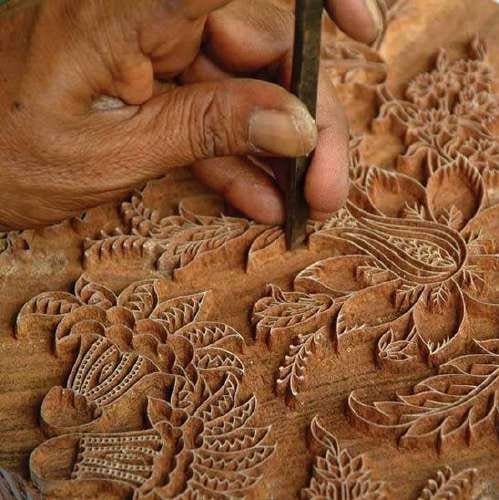India is a country rich in textiles, dyeing and printing techniques, and embroideries, all of which have contributed significantly to the evolution and beautification of fashion and design. There are several traditional textiles, embroideries, prints, and dyeing techniques that have been adopted and appreciated by many international designers, fashion professionals, and fashion enthusiasts. These elements in art of clothing have not only contributed to the original form but have also been reconfigured by many. Fast fashion has showed humanity a plethora of styles and carefully done collections, clothing that has been in fashion for years, clothing that has fulfilled all of human being’s esthetic and utilitarian needs, and clothes that continues to evolve creatively with time. In this age of fast fashion, Indian textiles and wearable crafts are battling to get an eye of fashion enthusiasts.
As part of their contribution to ethical fashion, some emerging fashion labels around the world prefer sustainable designs and goods. In the current scenario, it is impossible to deny the reality that Indian textiles and wearable crafts have always been sustainable.
Ajrakh and Bagru are traditionally manufactured with natural dyes, Ayurvastra is completely made of organic textiles and herbal dyes,
Kantha of West Bengal is quilting that uses threads drawn from discarded sarees and dhotis and many
textiles are woven on handloom and spun on charkha. Many designer labels and businesses today combine the traditional textiles and crafts to produce contemporary clothing. These make in India
labels have become the worldwide face of Indian fashion, demonstrating how to carry sustainable
fashion products gracefully while yet creating a fashion statement that is as spectacular as fast fashion.
The relationship between the Make in India initiative and sustainability.
Make in India is a government initiative to encourage enterprises to develop, manufacture, and assemble products created in India, as well as to reward focused investments in manufacturing.
The policy approach was to foster an investmentfriendly environment, build modern and efficient
infrastructure, and open new sectors to foreign investors. The project aims to “turn India into a
worldwide design and manufacturing export hub” by focusing on 25 economic areas for job development and skill training.

“Make in India” has three stated goals:
·To improve the industrial sector’s annual growth rate to 12-14%
·To bring 100 million new manufacturing jobs to the economy by 2022.
·To ensure that the manufacturing sector’s contribution to GDP reaches 25% by 2022. (Later revised to 2025).
Individual states developed their own local efforts in accordance with Make in India, such as “Make in Odisha,” “Tamil Nadu Global Investors Meet,” “Vibrant Gujarat,” “Happening Haryana,” and “Magnetic Maharashtra.”
Automobiles, aviation, biotechnology, chemicals, construction, defense manufacturing, defense exports, electronic systems, electrical machinery, food processing, exports, information technology, leather, media and entertainment, mining, oil and gas, pharmaceuticals, ports & shipping, railways, rapid transit, roads and highways, thermal power, textiles and garments, tourism, and wellness and healthcare were all covered by this initiative.
We are aware of this initiative and understand it focuses on creating new employment opportunities and boosting the nation’s GDP while climbing the global manufacture of products and advancement
ladder. This initiative goes beyond financial and technological development.
The Make in India project has pushed the concept of preserving India’s handmade products and traditional heritage crafts. It has also taken steps to engage Indian artists and promote crafts that have been revered by the nation for ages but are on the risk of extinction.
This initiative is a positive move towards entrepreneurship in the aforementioned domains, as well as a boon to the textile and fashion industries. By blending ancient weaves, prints, and patterns with current
fashion, the Indian fashion industry is gradually restoring the beauty of old crafts. It also offers employment for the artisans who have been into weaving, printing, and dyeing for generations now.
While artisans and designers work together to revitalize Indian heritage crafts, they create items that are zero waste and sustainable. They also promote traditional products that are more eco-friendly and are made with fewer or no chemicals.
There is growing interest in how sustainable entrepreneurship may balance human development, profit generation, and environmental protection to produce better social, economic, and environmental outcomes. To achieve order to prosper, enterprises must build sustainable business processes, stakeholder engagement, and sustainable innovations. As these companies are put up with a wish to help India’s artisanal networks, the practices of such entrepreneurs contribute to social upliftment and have a good influence on the environment.

How can you make a difference in India as a sustainable fashion
entrepreneur?
India ranked fourth in the world for ease of starting a business, according to the GEM (Global Entrepreneurship Monitor) 2021/2022 Report. India is therefore one of the top five countries to launch a new business. In terms of various entrepreneurial framework conditions, such as entrepreneurial finance, ease of access to finance, government policy: support and relevance, and government support: taxes and bureaucracy,
India has topped low-income economies (according to GDP per capita), while government entrepreneurial programmes came in second. According to the Economic Survey 2021–22, India has approximately 61,400 startups recognized by the Department for Promotion of Industry and
Internal Trade (DPIIT), with at least 14,000 recognized for the fiscal year 2022.
Entrepreneurship has enormous potential in a developing nation like India. Entrepreneurship can
be used to address the growing issue of underemployment and unemployment. The Indian fashion sector has established a niche and is demonstrating its strength in the market. Additionally, it has a big chance to expand soon to include buyers, sellers, employers, and employees.

Fashion entrepreneurs may help by engaging in sustainability by:
A reduction in CO2 emissions
·A reduction in textile waste
·Reduce the usage of chemicals that are harmful to both the environment and the human body.
·Less microfibers and microplastics that eventually find their way into the ocean or the bodies of humans.
·Entrepreneurs contribute significantly to avoiding the landfilling of nonbiodegradable trash by producing clothing in a sustainable manner. For instance, compared to any natural material, nylon takes longer to degrade.
·With sustainable production, business owners also assist in giving craftsmen a job who are in danger of losing their skill owing to a lack of labor.For instance, many traditional weavers, dyers, printers, and fabric painters are struggling to find work today. This industry has also been severely impacted by the pandemic, and many craftspeople are now switching to jobs that pay them more and provide them with steady work. When business owners engage these artists, they not only create jobs but also help to keep the craft alive. Many of these crafts make use of handlooms or environmentally friendly natural dyes and colors.
By employing members of the artisan community, using sustainable production practises, and sourcing sustainable raw materials when we manufacture our products in India, we not only operate a business with a novel concept but also give less fortunate artisans work, reduce environmental damage, and produce goods that are suitable for the global market. These businesspeople also reduce the amount of money the country spends on garbage management.

Lack of customers is one of thesebusinesses’ biggest issues! Simply because they are more expensive, people prefer to purchase sustainable items. These sustainable fashion products are much more expensive than synthetic textiles and objects that have undergone chemical processing, and for some demographics, they are also more fashionable.

By: Kshipra Gadey
Fashion Design Faculty,
INIFD Kothrud

